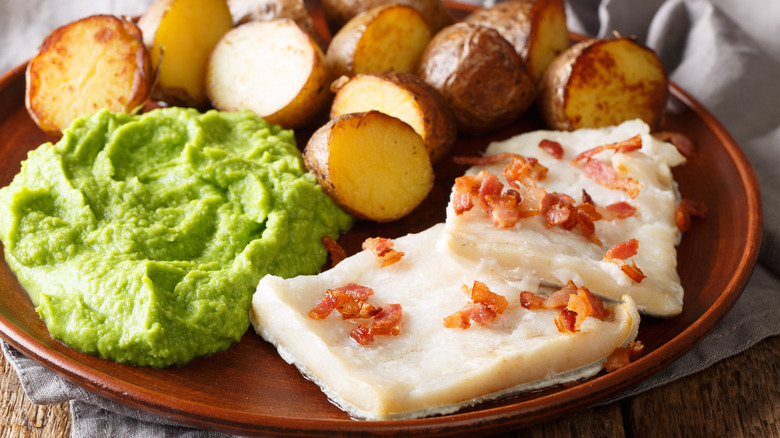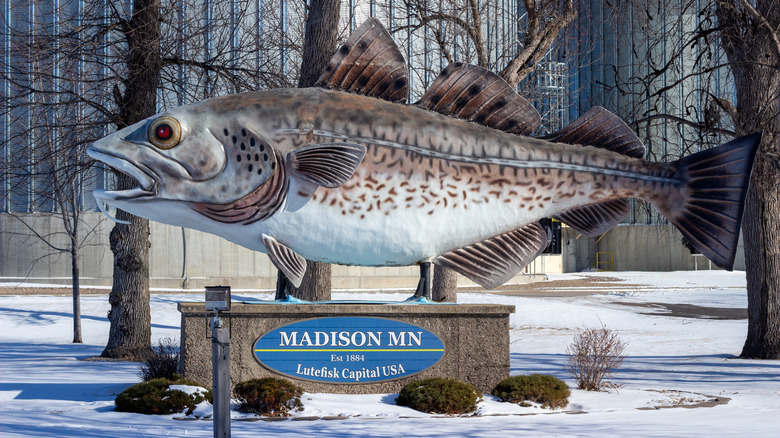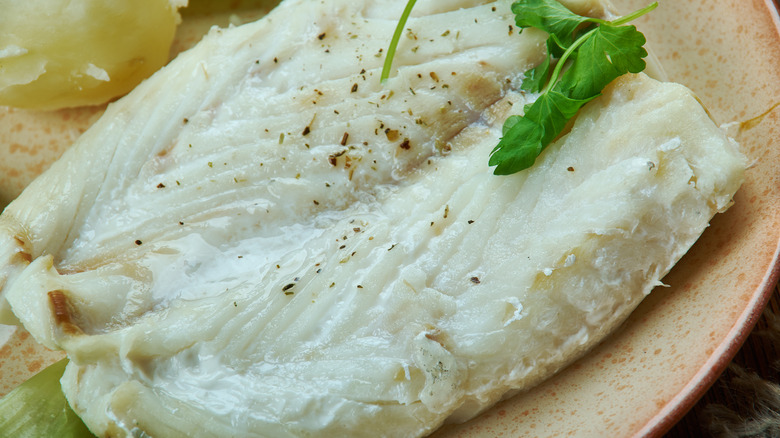The Only 2 States In The Country That Like Lutefisk
I'm a Midwesterner. Well, actually I'm a Southerner by birth, but after steeping in Chicago and Michigan for over half my life, I feel I've earned the right to fly both flags. As a Midwesterner, I've experienced my fair share of unique culinary delicacies this wide swath of the nation has to offer. I've taken down quite a few Italian beefs, scarfed Maid-Rite sandwiches in Iowa, thrown back golden fried cheese curds, and tried my hand at mammoth tenderloin sandwiches in Indiana. But there is one delicacy that has eluded me, partially because it is hyper-regional in popularity and partially because it is quite divisive.
I'm talking, of course, about lutefisk, a Scandinavian staple that is a perennial member of the pantheon of "gross foods" that few have actually tried, along with limburger cheese and durian. The concept of lutefisk — literally "lye fish" in Norwegian — is pretty simple and harkens back to the days before refrigeration. Cod, haddock, ling, or pollack is dried and treated with lye, then soaked in water before being steamed, baked, or poached until it is flaky.
As you can imagine, both the utility of and desire for lutefisk has waned in the past century. But Scandinavians — who, remember, get credit for one of the planet's most outlandishly delicious hot dogs — are a proud and traditional lot, and as such, pockets of lutefisk love persist. These are mostly in the Midwest, where many a Scandinavian settled, and, to be more pointed, in Minnesota and Wisconsin.
Minnesotans love lutefisk
Minnesotans aren't a monolith. The Land of 10,000 Lakes is home to a diverse population of Hmong, Somali, Mexican, Chinese, Native American, and Liberian people, to name just a few. But it was settlers from Norway, Sweden, Denmark, and Finland that settled in Minnesota, an environment not unlike their native lands, and brought with them scads of culinary customs. While time and tastes may have passed certain dishes and foodstuffs by, the connection to a shared heritage is one that dies hard, perhaps explaining why so many Minnesotans — and not just those of Scandinavian extraction — happily slurp down lutefisk.
While there are likely many Minnesota households that serve lutefisk (and it has even been featured at the state fair), the seafood is most commonly seen at large community suppers, often hosted by churches. Lutefisk is served gently steamed, its flaky, somewhat gelatinous — thanks to the lye bath — texture yielding under copious amounts of butter. Alongside, you'll likely find potatoes, mashed or boiled, vegetables, lefse, a type of flatbread, and maybe a cranberry salad to cut the overall richness. It's a hearty homestyle meal that brings people together, and central to it all is a fish that is both mild and mysterious.
In Wisconsin, an acquired tastes brings communities together
Not to be outdone, Minnesota's neighbors to the southeast, Wisconsin, have a soft spot for lutefisk. Many a Scandinavian settled in the state too, and much like in Minnesota, they brought a taste for dried, lye-brined fish with them. In fact, they even literally brought lutefisk with them, packing it into their suitcases for sustenance, unsure of what lay in store for them in their new homeland.
Churches and community groups still hold the most sway over lutefisk in Wisconsin, much like Minnesota. Families, friends, neighbors, and parishioners gather year after year to soak, cook, and debone mountains of lutefisk that are served on heaping platters to eagerly-waiting diners hungry for the singular taste and smell. That is to say nothing of the army of folks it takes to make the lefse, melt the requisite butter, mash potatoes, whip up cranberry relish, and perform the litany of tasks it takes to make a lutefisk supper shine. While it may not be everyone's cup of tea, for those who gladly stomach lutefisk and its trappings, the experience is one that encompasses tradition, nostalgia, cultural identity, and more.


